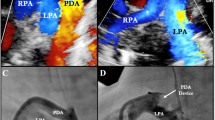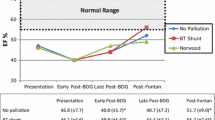Summary
Fifty very low birth weight (VLBW) infants (750–1500 g, 27–33 weeks gestational age) were assigned at random to one of two groups of negative fluid balance and underwent prospective clinical and echocardiographic examinations during the first month of life. The purpose was to determine: (a) the effect of fluid restriction on the incidence of ductal shunting, (b) the reliability of the physical examination in diagnosing significant ductal shunting, and (c) the relationship between significant ductal shunting and outcome in such infants. None of the infants had manipulations to close the ductus during the first week of life. Using routine structural and functional echocardiographic indices as criteria for the diagnosis of hemodynamically significant ductal shunting (hsPDA), we found that the two fluid-balance groups (8%–10% weight loss vs 13%–15% weight loss) did not significantly differ in incidence of hsPDA, duration of ventilation, or development of BPD. These two groups were then combined for further analysis: 32 (64%) of 50 VLBW infants had hsPDA during the first week of life. The group of infants with hsPDA did not differ significantly from that without hsPDA in birth weight or gestational age, but had a significantly lower Apgar score (P<0.04) and was significantly more likely to require ventilator support for RDS (P<0.01). Although when present a typical ductal murmur was specific for the development of significant ductal shunting, no murmur was heard in 21 (66%) of 32 infants with early hsPDA. Of the infants requiring ventilator support for RDS, the group with early hsPDA needed ventilation for 13.8±9.4 days, significantly longer than the group without early hsPDA (3.2±2.6 days,P<0.001), and had a higher incidence of BPD and death than the group without early hsPDA (P<0.04). In our study of a large group of prospectively identified VLBW infants, we did not find that significant ductal shunting was altered by more stringent fluid restriction, but we did find that such shunting was frequently inapparent clinically, and was associated with significantly increased morbidity and mortality.
Similar content being viewed by others
References
Baylen B, Meyer RA, Kaplan S, Ringenburg W, Korfhagen J (1975) Premature infant with patent ductus arteriosus and pulmonary disease: an echographic assessment.J Pediatr 86:423–432
Baylen B, Meyer RA, Korfhagen J, Benzing G III, Bubb M, Kaplan S (1977) Left ventricular performance in the critically ill premature infant with patent ductus arteriosus and pulmonary disease.Circulation 55:182–188
Bell EF, Warburton D, Stonestreet BS, Oh W (1980) Effects of fluid administration on the development of symptomatic patent ductus arteriosus and congestive heart failure in premature infants.N Engl J Med 302:598–603
Clyman RI, Mauray F, Roman C, Rudloph AM, Heymann MA (1980) Circulating prostaglandin E2 concentrations and patent ductus arteriosus in fetal and neonatal lambs.J Pediatr 97:455–461
Cotton RB, Stahlman MT, Bender H, Graham T, Catterton W, Kovar I (1978) Randomized trial of early closure of symptomatic ductus arteriosus in small preterm infants.J Pediatr 93:647–651
Danilowicz D, Rudolph AM, Hoffman J (1966) Delayed closure of the ductus arteriosus in premature infants.Pediatrics 37:74–79
Friedman WF, Fitzpatrick KM, Merritt TA, Feldman BH (1978) The patent ductus arteriosus: symposium on the respiratory system.Clin Perinatol 5:411–435
Gay JH, Daily WJR, Meyer B, Trump D, Cloud D, Molthan M (1973) Ligation of the patent ductus arteriosus in premature infants: report of 45 cases.J Pediatr Surg 8:677–683
Gersony WM, Peckham GJ, Ellison RC, Miettinen OS, Nadas AS (1983) Effects of indomethacin in premature infants with patent ductus arteriosus: results of a national collaborative study.J Pediatr 102:895–906
Gillman RG, Burton AC (1966) Constriction of neonatal aorta by raised oxygen tension.Circ Res 19:755–765
Hornbird PY (1969) Embryological observations of the ductus arteriosus in the guinea pig, rat and mouse: studies on the closure of the ductus arteriosus.Acta Physiol Scand 76:49–57
Jacob J, Gluck L, DiSessa T, Edwards D, Kulovich M, Kurlinski J, Mettet T, Friedman W (1980) The contribution of patent ductus arteriosus in the neonate with severe respiratory distress syndrome.J Pediatr 96:79–87
Kitterman JA, Edmunds H, Gregory G, Heyman M, Tooley W, Rudolph A (1972) Patent ductus arteriosus in premature infants: incidence, relation to pulmonary disease and managementN Engl J Med 287:473–481
Lorenz JM, Kleinman LI, Kotagal UR, Reller MD (1982) Water balance in very low birth weight infants: relationship to water and sodium intake and effect on outcome.J Pediatr 101:423–432
Mahony L, Carnero V, Brett C, Heymann MA, Clyman RI (1982) Prophylactic indomethacin therapy for patent ductus arteriosus in very-low-birth-weight infants.N Engl J Med 306:506–510
McGrath RL, McGuinness G, Way GL, Wolfe R, Nora J, Simmons M (1978) The silent ductus arteriosus.J Pediatr 93:110–115
Merritt TA, Harris JP, Roughmann K, Wood B, Campanella V, Alexson C, Manning J, Shapiro D (1981) Early closure of the patent ductus arteriosus in very low birth weight infants: a controlled trial.J Pediatr 99:281–286
Murphy DM, Heymann M, Rudolph AM, Melmon K (1972) Constriction of the ductus arteriosus.Pediatr Res 6:231–238
Naeye RL (1961) Arterial changes during the perinatal period.Arch Pathol 71:121–128
Northway HQ, Rosen RC, Porter DY (1969) Pulmonary disease following respiratory therapy of hyaline membrane disease.N Engl J Med 276:357
Rowe RD, Freedom RM, Mehrizi A, Bloom KR (1981)The neonate with congenital heart disease, 2nd edn. WB Saunders, Philadelphia, p 275
Rudolph AM (1974)Congenital disease of the heart, 1st edn. Year Book Medical, Chicago, pp 29–48 and 168–201
Siassi B, Emmanouildes G, Cleveland R, Hirose F (1969) Patent ductus arteriosus complicating prolonged assisted ventilation in respiratory distress syndrome.J Pediatr 74:11–16
Thibeault D, Emmanouilides G, Dodge M, Lachman R (1977) Early functional closure of the ductus arteriosus associated with decreased severity of respiratory distress syndrome in premature infants.Am J Dis Child 131:741–745
Valdes Cruz LM, Dadell GG (1981) Specificity and accuracy of echocardiographic and clinical criteria for diagnosis of patent ductus arteriosus in fluid restricted infants.J Pediatr 98:298–305
Author information
Authors and Affiliations
Additional information
This research was supported in part by Children's Hospital Research Foundation; DHHS-USPHS, MCH grant 000174; American Heart Association, SWOC; and by DRR CLINFO grant RR00068-18-52, General Clinical Research Center.
Rights and permissions
About this article
Cite this article
Reller, M.D., Lorenz, J.M., Kotagal, U.R. et al. Hemodynamically significant PDA: An echocardiographic and clinical assessment of incidence, natural history, and outcome in very low birth weight infants maintained in negative fluid balance. Pediatr Cardiol 6, 17–23 (1985). https://doi.org/10.1007/BF02265403
Issue Date:
DOI: https://doi.org/10.1007/BF02265403




